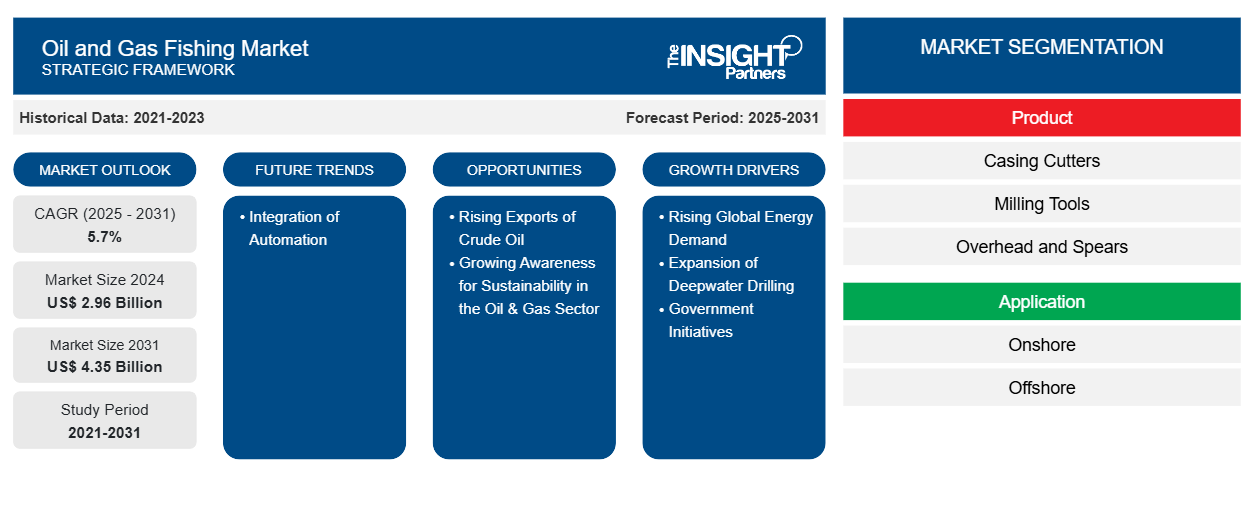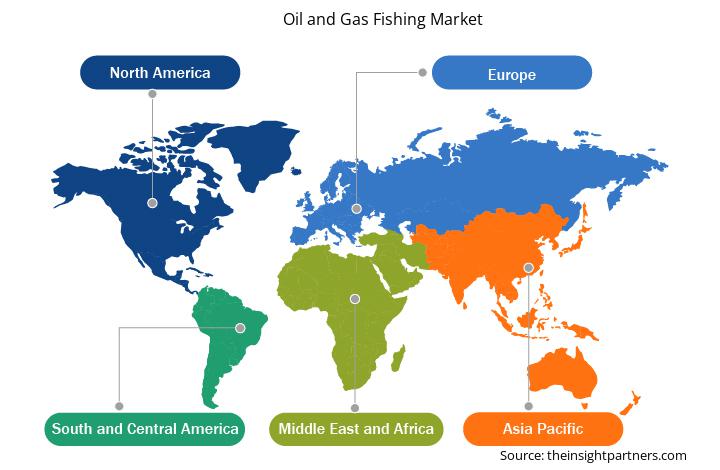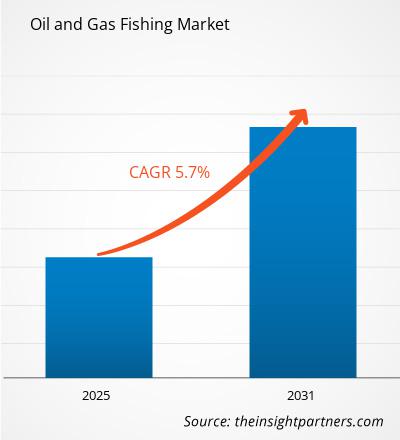预计到2031年,油气捕捞市场规模将从2024年的29.6872亿美元增至43.5506亿美元。预计2025年至2031年期间,该市场的复合年增长率将达到5.7%。自动化的融合可能会在未来几年为市场带来新的趋势。
石油和天然气渔业市场分析
由于经济增长、工业发展和能源需求的不断增长,全球对原油的需求正在增长。供应不确定性和能源安全等因素促使产油国提高产量。因此,许多国家更加注重原油出口,以满足全球需求并支持本国经济发展。
原油出口是这些国家的主要收入和外汇来源。这使其能够投资基础设施、技术和其他经济领域。各国都致力于增加出口量,以扩大市场份额并吸引外国对石油和天然气的投资。原油出口的增长为油气捕捞市场提供了巨大的机遇。钻井和油井维护等上游活动的增加,导致需要渔业服务来打捞卡住的工具或设备,从而最大限度地减少停工时间和生产损失的情况增多。
印度正在将其炼油产能从2020年的2.5亿吨/年扩大到2030年的4.5亿吨/年,以满足国内和出口需求。同样,根据国际能源署2024年1月的数据,沙特阿拉伯拥有全球约17%的已探明石油储量,是最大的原油出口国之一。沙特阿美公司正在大力投资勘探和生产等上游业务,以保持其领先的出口地位。原油产量和出口量的扩张将推动对渔业服务的需求,为全球服务提供商创造增长机会。
石油和天然气渔业市场概况
石油工业对于满足世界能源需求至关重要,尤其是在勘探和钻井等上游作业中。在钻井作业中,钻头、套管或管道等工具和设备有时会卡在井筒中或丢失。打捞作业对于打捞这些物件并继续钻井作业而不造成重大中断至关重要。
油田打捞是指将遗留在井筒中的不良材料或设备打捞出来。这些情况可能是由于机械故障、井壁不稳定、地层损坏、井漏、井斜或人为失误(例如操作不当或工具掉落)造成的。为了打捞被卡或丢失的设备,通常会使用打捞震击器、打捞筒、打捞矛或连续油管等专用工具。这些工具旨在抓紧或锁定设备,并将其安全地带回地面。
您可以免费定制任何报告,包括本报告的部分内容、国家级分析、Excel 数据包,以及为初创企业和大学提供优惠和折扣
石油和天然气渔业市场:战略洞察

-
获取此报告的顶级关键市场趋势。此免费样品将包括数据分析,从市场趋势到估计和预测。
石油和天然气渔业市场的驱动力和机遇
扩大深水钻探
石油和天然气行业正在向深水和超深水钻探领域扩张,因为企业需要最新的储备来满足日益增长的全球能源需求。这些海上项目通常位于更加复杂和高风险的环境中,需要先进的技术和高技能的作业。
壳牌表示,其更多的油气产量来自深水业务,该业务可提供更高利润和更低碳的石油。该公司正在积极开发墨西哥湾的大型项目,包括Vito(于2023年投产)、Whale(其在该地区的第14个深水开发项目)和Sparta(正在建设中,预计将于2028年投入运营)。这些项目体现了壳牌对深水扩张的承诺,并凸显了整个行业向海上勘探迈进的广泛趋势。
深水作业面临着诸多技术挑战。在如此深的深度进行钻井作业,需要应对高压、高温和复杂的井身结构。这增加了卡钻、工具丢失或堵塞的风险——这些问题可能会导致钻井停止并造成代价高昂的停工。石油和天然气公司依靠打捞服务来解决这些问题。打捞需要使用特殊工具从井中打捞丢失或卡住的设备。这些工具必须高度先进,并由经验丰富的工作人员操作,才能在深水环境中安全有效地工作。因此,深水钻井的扩张推动了石油和渔业市场的发展。
石油和天然气行业可持续发展意识不断增强
石油和天然气行业对可持续性和环境责任的关注日益加深。企业正在采用更清洁的技术,减少排放,并提高运营效率,以满足更严格的环境法规,并满足日益增长的可持续实践需求。可持续实践需要使用先进、可靠、高效的打捞工具和服务,以最大限度地降低环境风险并减少停工时间。打捞作业在维护油气井完整性以及防止危害环境的泄漏或溢漏方面发挥着关键作用。
企业正在投资更安全、更环保的最新技术。这包括旨在减少浪费、降低能耗、处理复杂井况且不造成损害的打捞工具。随着可持续性成为优先事项,石油和天然气运营商愿意在有助于实现环境目标的服务上投入更多资金。环保工具和服务的开发可以为石油和天然气打捞市场参与者创造充足的机会。
石油和天然气渔业市场报告细分分析
石油和天然气渔业市场分析的关键部分是产品和应用。
- 按产品分类,市场分为套管切割器、铣削工具、顶置式震击器和长矛、震击器及其他。2024年,顶置式震击器和长矛占据了市场主导地位。
- 根据应用,市场分为陆上和海上。2024年,陆上市场将占据主导地位。
石油和天然气渔业市场份额按地区分析
油气捕捞市场主要分为五大区域:北美、欧洲、亚太地区 (APAC)、中东和非洲 (MEA) 以及南美和中美 (SAM)。2024 年,北美占据市场主导地位,其次是中东和非洲以及亚太地区。
北美市场分为美国、加拿大和墨西哥。受原油产量巨大推动,北美在全球油气捕捞市场中占据着强大的领先地位。根据国际能源署 (IEA) 的数据,2022 年北美占全球原油产量的 22%。原油从陆上和海上油井抽出,然后通过管道或油轮运输到炼油厂,在那里被加工成汽油、柴油等燃料以及工业化学品。然而,在钻井或油井作业过程中,设备故障或事故可能导致需要捕捞服务,即从井筒中打捞丢失、卡住或损坏的工具和设备。
在北美,尤其是美国和加拿大,对石油和天然气的持续需求导致钻探活动增加。根据美国能源信息署 (EIA) 的数据,截至 2024 年,美国仍是世界上最大的石油生产国,平均原油日产量约为 1320 万桶。这种高水平的活动导致运营挑战增多,从而刺激了对渔业服务的需求。
石油和天然气渔业市场区域洞察
Insight Partners 的分析师已详尽阐述了预测期内影响石油和天然气渔业市场的区域趋势和因素。本节还讨论了北美、欧洲、亚太地区、中东和非洲以及南美和中美洲的石油和天然气渔业市场细分和地理位置。

- 获取石油和天然气渔业市场的区域具体数据
石油和天然气渔业市场报告范围
| 报告属性 | 细节 |
|---|---|
| 2024年的市场规模 | 29.6亿美元 |
| 2031年的市场规模 | 43.5亿美元 |
| 全球复合年增长率(2025-2031) | 5.7% |
| 史料 | 2021-2023 |
| 预测期 | 2025-2031 |
| 涵盖的领域 |
按产品
|
| 覆盖地区和国家 |
北美
|
| 市场领导者和主要公司简介 |
|
石油和天然气渔业市场参与者密度:了解其对商业动态的影响
油气渔业市场正在快速增长,这得益于终端用户需求的不断增长,而这些需求的驱动因素包括消费者偏好的转变、技术进步以及对产品优势的认知度的提升。随着需求的增长,企业正在扩展产品线,不断创新以满足消费者需求,并抓住新兴趋势,从而进一步推动市场增长。
市场参与者密度是指特定市场或行业内企业或公司的分布情况。它表明特定市场空间内竞争对手(市场参与者)的数量相对于其规模或总市值而言。
在石油和天然气渔业市场运营的主要公司有:
- 贝克休斯公司
- 服务负载平衡
- 哈里伯顿公司
- NOV公司
- 威德福国际公司
- 阿彻有限公司
免责声明:以上列出的公司没有按照任何特定顺序排列。

- 获取石油和天然气渔业市场顶级关键参与者的概述
石油和天然气渔业市场新闻和最新发展
油气捕捞市场评估是通过收集一手资料和二手资料后进行的定性和定量数据进行的,这些数据包括重要的企业出版物、协会数据和数据库。以下列出了油气捕捞市场的一些关键发展:
- 壳牌已将巴西、苏里南和圣多美和普林西比的多个重要项目授予哈里伯顿。在巴西,哈里伯顿与壳牌签署的合同标志着桑托斯盆地盐下层加托杜马托深水油田开发项目的重要里程碑。哈里伯顿凭借其在钻井建设、完井和干预方面的一体化方案而获此殊荣。(来源:壳牌,新闻稿,2025年5月)
- 哈里伯顿公司与巴西石油公司签订合同,为巴西提供一体化修井和海上封堵服务,包括流体、完井设备、电缆、松弛线、回流服务和连续油管。(来源:哈里伯顿,新闻稿,2024年8月)
石油和天然气渔业市场报告覆盖范围和交付成果
《石油和天然气渔业市场规模和预测(2025-2031)》对以下领域进行了详细的市场分析:
- 石油和天然气渔业市场规模以及全球、区域和国家层面涵盖的所有关键市场领域的预测
- 石油和天然气渔业市场趋势,以及市场动态,如驱动因素、限制因素和关键机遇
- 详细的 PEST 和 SWOT 分析
- 石油和天然气渔业市场分析涵盖主要市场趋势、全球和区域框架、主要参与者、法规和最新市场发展
- 行业格局和竞争分析,涵盖市场集中度、热图分析、知名参与者以及石油和天然气渔业市场的最新发展
- 详细的公司简介
- 历史分析(2 年)、基准年、预测(7 年)及复合年增长率
- PEST和SWOT分析
- 市场规模、价值/数量 - 全球、区域、国家
- 行业和竞争格局
- Excel 数据集
近期报告
客户评价
购买理由
- 明智的决策
- 了解市场动态
- 竞争分析
- 客户洞察
- 市场预测
- 风险规避
- 战略规划
- 投资论证
- 识别新兴市场
- 优化营销策略
- 提升运营效率
- 顺应监管趋势






















 获取免费样品 - 石油和天然气渔业市场
获取免费样品 - 石油和天然气渔业市场